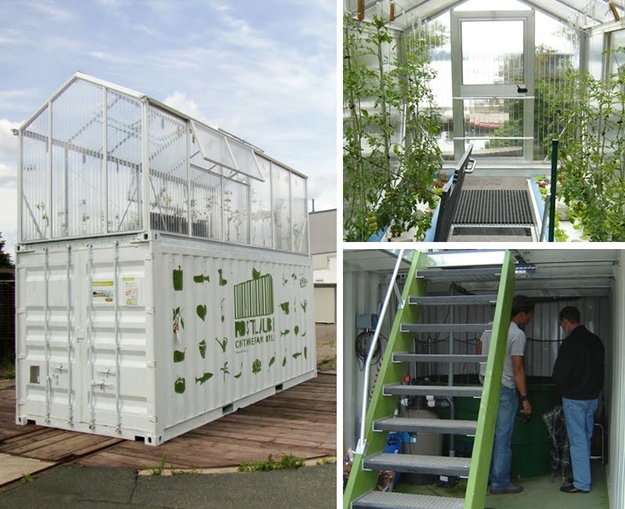The greenhouse design is based on the circular agriculture technique aquaponics: a sustainable production process that combines aquaculture and hydroculture. Micro-Farms can be parked anywhere in the city, becoming a seamless part of the urban environment. The project is open source, which means anyone can download the 3D sketch of the system and create his or her own urban oasis. With Micro-Farm, cultivating your own food and forming an urban food network is just around the corner. Exhibited from April 4 to May 4 2012 at ENSCI (École nationale supérieure de création industrielle, Paris).
Damien Chivialle is a designer who works with containers since 2006. We had the chance to talk with him and he answered a few of our questions.
Is your project conceived as an artwork, or as a solution to a societal problem?
Both. Micro Farms symbolizes the precarious balance we find in cities between nature and the built environment, but it's also a very pragmatic solution to a serious problem.
When was the idea for Micro Farms born?
It all started with ISO shipping containers. With the end of fossil fuels in sight, the way we exchange goods around the world is going to radically change. Big shipping companies are developing an ultralight container to replace the current design, which means soon we'll be left with a lot of unused containers. At the same time cities are rapidly expanding, causing new problems for the transportation of goods. What if we were to produce inside the city itself? And can we use the soon-to-be abandoned containers to do so?
So is your choice to use containers only based on a sustainable recycling need, or are there other reasons?
First of all I was thinking about producing in an urban environment. It's too risky to put a greenhouse on the street. On top of a container, however, it would be perfectly fine. Secondly, it would be really easy to transport the Micro Farm, because the ISO container is an international standard. On site, the empty container can be used for production, even in places where the ground is polluted.
Why did you choose to use the aquaponics system?
To feed cities you need to do a lot (population increase) with little (everything is expensive). Using a circular system only makes sense: it loops production, and optimizes space and inputs. But people are a little taken aback when they see an aquaponic system. However, there's nothing mysterious about aquaponics. In fact, it is actually quite expressive and transparent. First, bacteria turn fish waste into nutrients. Second, the nutrients allow vegetables to grow. Third, the vegetables filter the water and return it to the fish all clean.
Can you say something about the development of Micro Farms?
First, I drew the conceptual system and spread the 3D model on the web in order to attract investors. Then I designed the structure (greenhouse on the container) and Urbanfarmers sized the aquaponics set in Zurich. The interior design is up to the user. For instance, the Zurich and Berlin farms each feature a 2m3 fish tank and two big hydroponics gutters. But in Brussels we're thinking about a mix between hydroponic flow tables and traditional ground baskets. You can really do almost anything you please.
